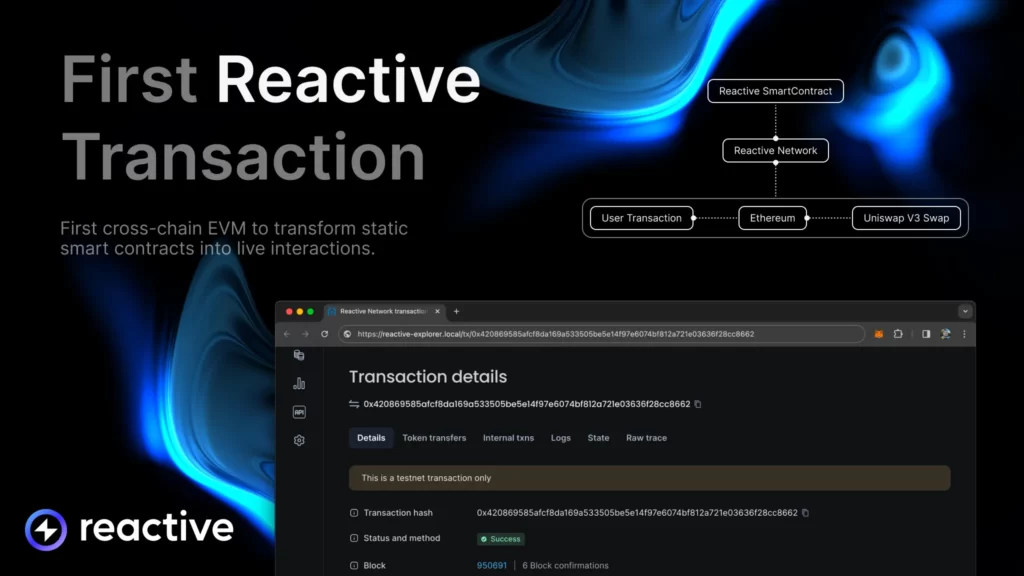In a significant leap forward for Reactive Network, the first cross-chain EVM to convert static smart contracts into live interactions by PARSIQ, the platform has successfully executed its first reactive transaction. This marks a momentous achievement in decentralized blockchain technology, demonstrating the potential of seamless automated cross-chain communications.
One small step for developers, one giant leap for #ReactiveSmartContracts
We’re happy to share that Reactive Network completed its first-ever Reactive transaction yesterday!
You can find out more about this important development milestone here on our blog: https://t.co/pFtYRXE6sR pic.twitter.com/EvGxVNR7FA
— Reactive network | powered by PARSIQ (@0xReactive) January 19, 2024
This development underlines Reactive Network’s commitment to facilitating on-chain responses to events across blockchain ecosystems, and ushers in a new era of multi-chain interactivity. The groundbreaking transaction took place in response to a Uniswap V3 swap involving the PARSIQ Token (PRQ), providing a tangible demonstration of the capabilities of Reactive Smart Contracts (RSCs) in action. This achievement marks not only a technological triumph, but also a step toward unlocking the practicality of Reactive Network in real-world scenarios.
Reactive Network’s unique approach to Blockchain interactivity
Reactive Network, or simply Reactive, represents a paradigm shift in the evolution of blockchain technology. The primary goal is to establish a unified and reliable environment for multi-chain interactivity, streamlining the development process of decentralized applications (dApps) across diverse blockchain ecosystems.
What sets Reactive apart is its innovative solution to the ‘Blockchain Oracle problem’ through an event-driven approach. Reactive Network leverages the principles of reactive programming and extensions and introduces the concept of Reactive Smart Contracts (RSCs). These contracts are not based on user interactions, but on data streams from multiple blockchain ecosystems, offering a new approach to decentralized computation.

The completion of the first Reactive transaction is a major milestone for Reactive Network. Activated by a Uniswap V3 swap from PRQ, this transaction illustrates the practicality of Reactive Smart Contracts. In addition to the technical implications, this achievement opens the door to a new generation of interactive dApps and Smart Contracts that transcend the boundaries of their own ecosystems.
Daniil Romazanov, CTO of PARSIQ, reflects on the milestone and highlights: “This first Reactive transaction is an important milestone in the development of Reactive Network and marks the team’s commitment to achieving the objectives set for it. But it is not a time for us to relax; there are still many problems to be solved and research to be done. The team is juggling many flows simultaneously, including event consensus, passing, evidence mechanisms, and much more.”
Scalability and efficiency at the core
Reactive Network stands out for its remarkable scalability, made possible by parallelizing the Ethereum Virtual Machine (EVM). The concurrent execution of Reactive Smart Contracts allows developers to transfer data-driven computations from the primary blockchain layer. This transition not only reduces gas consumption, but also benefits from the cost-effectiveness of state changes.
The result is an improved, scalable blockchain ecosystem that will transform our understanding of blockchain interactivity and dApp development. Because today’s successful reactive transaction marks just the beginning for Reactive Network, the platform aims to bridge the gap between different blockchain ecosystems.
This achievement not only has technical implications, but also opens the door to practical applications in the real world. The hope is that Reactive Network will emerge as a pioneer in a new era of blockchain technology, unlocking limitless possibilities for developers and users in the decentralized application landscape and beyond.


